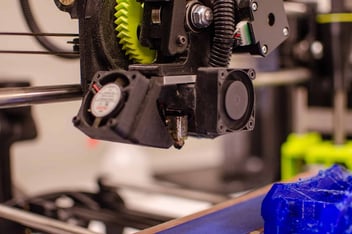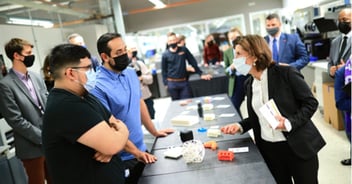3D printing (the primary form of additive manufacturing) has truly changed the game for prototyping and production of parts. Since the introduction of the first technology, Vat Polymerization, manufacturers and product designers have been able to speed up the process of design, prototyping and production immensely. Today, there are a number of technologies in the space that offer a broad set of options for designers, producers, and manufacturers alike. As technology advances, the central question is: is 3D printing ready for production?
What is additive manufacturing?
Additive manufacturing, or 3D printing, is a process in which material is selectively added to a create a physical part. It differs from traditional computer numeric controlled (CNC) processes that selectively remove material to create desired geometric shapes. 3D printing has been around since the 1970s, but it didn’t gain popularity until late 2000s with the rise of the open source movement and the launch of affordable printers on crowd funding platforms. Some of the technologies are now democratized, and for $200 you can buy a decent 3D printer that is considered reliable to a makers’ standard.
There are seven main types of 3D printing process: Fuse Deposition Modeling (FDM), Vat Polymerization (SLA & DLP), Material Jetting, Powder Bed Fusion, Binder Jetting, Directed Energy Deposition, and Sheet Lamination. Each technology has its pros and cons and for that reason, there are advantages to prototyping with a service bureau that has several of the printing technologies to get the best part for a specific application.
- Technology Fuse Deposition Modeling (FDM): Heated extruder that melts plastic filament and dispenses it in a bed layer by layer.
- Vat Polymerization (SLA and DLP): UV light selectively cures liquid resin in a tank. Resin is a photosensitive polymer that crosslinks and hardens into a solid under UV exposure.
- Material Jetting: Material is selectively jetting from a printer head and then UV light cures the entire bed. The part moves down a layer and additional material is jetting on top.
- Powder Bed Fusion: A layer of plastic or metal powder is spread on a flat bed in a heated oven. A laser then selectively sinters the powder to form a solid part. The part lowers down a layer and more powder is spread on top.
- Binder Jetting: Another powder-based system that uses a printer head, similar to an inkjet printer, to selectively deposit a binding solution onto a bed of powder. Just as in SLS, the part lowers down a layer and more powder is spread on top.
- Directed Energy Deposition: Like SLS, plastic powder sits in a heated chamber, but instead of using a laser to fuse the powder, it uses an inkjet array to selectively dispense a fusing agent that heats the powder over its melting temperature with heat lamps.
- Sheet Lamination: Compressed stacks of sheet material are bonded together to create a 3d part.
Is 3D printing ready for production?
For decades, 3D printing has been a game changer for quick prototyping iterations and has reduced time for product development. Rapid developments in additive manufacturing have introduced new processes and materials that are faster, more reliable, and deliver more resilient parts. With every advancement, the question is always: is 3D printing ready for production?
It will probably never meet the speed and low cost of injection molded parts, but the technology unlocks the geometric and material constraints of old manufacturing processes and opens the world to new products that were previously not manufacturable. Additive manufacturing is already happening today and there are several examples of 3D manufactured parts at scale. Adidas has sold over 100,000 of its 3D printed shoe that launched in 2017. BMW’s mini cooper has a 3D printed face plate for its dashboard that its users can fully customize.
It’s not just the advances in the technology of 3D printers themselves that enable mass production. There have been equal improvements in software, quality management, design thinking, and new business models that enable 3D printing to be scalable for production.
Design
These multiple advancements have changed design thinking. A generation of engineering students had access to 3D printers through their education and now, these graduates are incorporating additive manufacturing processes into their part designs. Injection molding and metal sheet forming are no longer the only options. With this new thinking, multiple machine and molded parts can be designed into one complex, lower cost, 3D printed part. GE engineers reduced 20 components of a fuel injection nozzle into one 3D printed part and have since mass produced 30,000 units with metal powder bed fusion machines. There have also been design software advancements that make it easy to create very complicated structures that minimize material usage and deliver precise performance characteristics. Autodesk is a leader in generative design. They offer CAD solutions that allow engineers to enter the requirements and constraints, like forces, mounting points, stiffness and weight, and the software creates the optimal geometry that meets the design goals. The automotive and aerospace industry will pay more for a solution that reduces the overall weight, increases strength, and reduces the part count without sacrificing performance. Most generative designed parts require additive manufacturing processes to produce the organic, lattice-like structures that reduce material usage and increase strength.
Operational Software
There have also been advances in operational software that reduce cost and increase the performance of additive manufactured parts. Much of the process of creating a build file is now automated. There used to be an art to packing parts into a 3-dimentional build tray. Now the task is optimized with a click of the button. Slicing algorithms which break down a 3-dimentional part into 2D layers and then create tool paths or instructions for the print head/laser have improved and now produce more predictable and reliable parts. Cost analysis is now a standard software feature that enables service bureaus to charge competitively, which further lowers the cost additive manufacturing.
Quality Management
Quality manufacturing and part consistency in additive manufacturing have been a barrier to mass production processes until recently. In the aerospace and automotive industry, where lives are often at stake, quality management is imperative. There is now a new suite of tools that manage quality, some of which are being developed at mHUB. Dr. Mike Vasquez of 3Degrees has launched a new product called TRACE. It is a software tool that tracks and stores information that is required for the traceability and quality management for 3D printed parts. Additive manufacturing is a new process and covers a variety of different methods of production and post processing. Monitoring and documenting all steps and settings are fundamental in managing part quality. With TRACE, you can document and generate reports of each part’s revision number, materials, settings, post processing procedures, and inspection methods that affect performance.
Offering access to entrepreneurs: what mHUB offers
mHUB’s 3D printing lab has four state of the art technologies: FMD, Vat Polymerization (SLA), SLS, and Material Jetting. Two of the four machines are available for member use, and the higher end printers are accessible through the oversight of mHUB corporate partner, Fisher Unitech, and mHUB's Prototyping shop engineers. On the member-operated side, there are two Form 2 SLA machines for high resolution and detail parts and three FDM machines when strength is needed. Members can turn to the commercial side of the lab when they are looking for performance models, high strength parts, or better material properties. The EOS Formiga P110 SLS machine creates very strong and very accurate nylon parts and has been the most popular machine for both prototype parts and low volume production parts when material performance and strength are prioritized. There are also three impressive Stratasys material jetting machines: J750 Multi-Material PolyJet, Objet 260vs Dental, and the Objet30 Prime. The J750 can print 6 unique materials at the same time which allows for 360,000 colors and multi durometer prints. There are also two FDM machines: the Fortus 450mc and the Stratasys F370, the former can print carbon fiber reinforced nylon for strength and high temperature materials like ULTEM. mHUB members get access to these machines below market rates, giving mHUB’s entrepreneurs an edge.
Disruption in additive manufacturing
On May 1st, 2019, Joseph DeSimone, CEO and Co-Founder of Carbon, joined the mHUB Industry Disruptors series stage to speak about how he is disrupting the additive manufacturing space with a new Vat Polymerization technology is that is 100 times faster than traditional SLA and DLP technologies. This technology adds to the deep bench of advancements in the 3d printing space. Get more information about upcoming events.
Explore mHUB's 3D Printing Capabilities :






